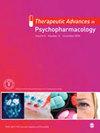Effect of long-acting antipsychotic treatment on psychiatric hospitalization rate in early psychosis patients: a naturalistic study
IF 3.4
3区 医学
Q2 PHARMACOLOGY & PHARMACY
引用次数: 0
Abstract
Background:The effectiveness of long-acting injectable (LAI) antipsychotics in preventing relapses of first-episode psychosis is currently debated.Objectives:The study aimed to investigate the number of psychiatric hospitalizations comparing the LAI cohort versus the oral cohort during different phases of the illness, pre-LAI treatment, during LAI treatment, and after LAI treatment.Design:A naturalistic study was conducted on two independent cohorts of early psychosis patients receiving treatment from a specific early intervention service. The first cohort comprised 228 patients who received LAIs, while the second cohort comprised 667 patients who had never received LAIs.Methods:This study was designed as a longitudinal observational study conducted within a naturalistic clinical setting in two cohorts of early psychosis patients. Repeated series ANCOVA (ANCOVA-r) was used to study the number of hospitalizations in the different study periods (T1 = from the date of the first psychiatric record to the beginning of the mirror period; T2 = the mirror period; T3 = from the LAI implementation to the LAI discontinuation; and T4 = from the LAI discontinuation to the end). In all cases, discontinuation of LAI involved the return to oral treatment. In all, 35 patients had not T4 as they were still on LAI treatment at the time of database closing (September 2020), and their data were not included in the analysis of the effect of the LAI discontinuation.Results:The patients in the LAI cohort were younger, more frequently males, presented more schizophrenia diagnoses, and had a higher number of hospitalizations (2.50 ± 2.61 versus 1.19 ± 1.69; p < 0.001) than the oral cohort. The number of hospitalizations at the end of the follow-up was higher in the LAI cohort [0.20 (standard deviation (SD)) = 0.79] versus 0.45 [SD = 0.45 (SD = 1.13); F(23.90), p < 0.001]. However, after the introduction of LAIs, the differences in hospitalization rates between the two cohorts became less pronounced. Once LAI treatment was ceased, the hospitalization rate increased again.Conclusion:In our study, early psychosis patients receiving LAIs experienced a greater decrease in hospitalizations after introducing the LAI treatment than those treated solely with oral medication. These findings support using LAIs as a viable strategy for preventing rehospitalization and improving the overall course of treatment for individuals with early psychosis.长效抗精神病药物治疗对早期精神病患者精神病住院率的影响:一项自然研究
背景:长效注射(LAI)抗精神病药物在预防首发精神病复发方面的有效性目前还存在争议。研究目的:本研究旨在调查在LAI治疗前、LAI治疗期间和LAI治疗后的不同疾病阶段,LAI队列与口服队列的精神病住院次数比较。方法:本研究设计为一项纵向观察研究,在自然临床环境中对两组早期精神病患者进行观察。重复序列方差分析(ANCOVA-r)用于研究不同研究时期(T1=从首次精神病记录日期到镜像期开始;T2=镜像期;T3=从实施LAI到停用LAI;T4=从停用LAI到研究结束)的住院次数。在所有情况下,停用LAI都需要恢复口服治疗。结果:与口服队列相比,LAI队列中的患者更年轻,男性更多,精神分裂症诊断更多,住院次数更高(2.50±2.61对1.19±1.69;p <0.001)。在随访结束时,LAI队列的住院次数[0.20(标准差(SD))= 0.79]对0.45[SD = 0.45(SD = 1.13);F(23.90),p <;0.001]更高。然而,在使用 LAI 后,两组患者住院率的差异变得不那么明显了。结论:在我们的研究中,与仅接受口服药物治疗的患者相比,接受LAI治疗的早期精神病患者在引入LAI治疗后的住院率下降幅度更大。这些研究结果支持将LAI作为预防再住院和改善早期精神病患者整体治疗过程的可行策略。
本文章由计算机程序翻译,如有差异,请以英文原文为准。
求助全文
约1分钟内获得全文
求助全文
来源期刊
CiteScore
7.90
自引率
2.40%
发文量
35
审稿时长
10 weeks
期刊介绍:
Therapeutic Advances in Psychopharmacology delivers the highest quality peer-reviewed articles, reviews, and scholarly comment on pioneering efforts and innovative studies across all areas of psychopharmacology. The journal has a strong clinical and pharmacological focus and is aimed at clinicians and researchers in psychopharmacology, providing a forum in print and online for publishing the highest quality articles in this area.

 求助内容:
求助内容: 应助结果提醒方式:
应助结果提醒方式:


